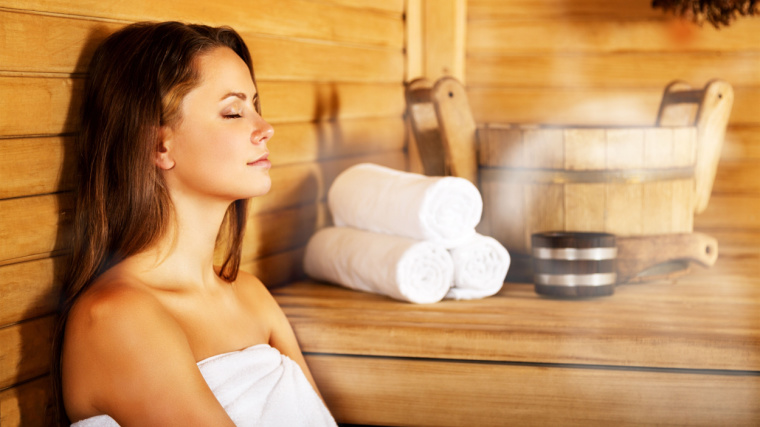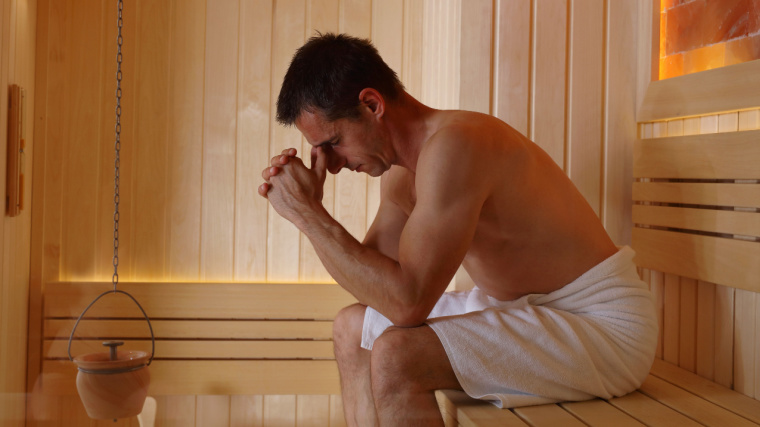Saunas are no modern concept. Their origins can be traced back at least 4,000 years. However, thousands of years later, the science behind them remains a mystery to many people. Why do so many athletes huddle in a sweaty corner after their workout? Have they not sweated hard enough already?
And yet, your gym locker room is packed with everyone from dedicated bodybuilders to weekend warriors wanting to get a sauna experience after tough workouts. After a cool down, athletes across the spectrum aim to heat up again in saunas, chasing the stress reduction, pain relief, and improved sleep associated with the heated rooms.

Sure, some of it is about personal preference — but you also want to set yourself up for both safety and success. So, how long should you stay in a sauna for maximum benefits? Read on to find out the sweet sweat spot.
What Is a Sauna?
A sauna is a dedicated room for exposing people to dry heat for relaxation purposes. Saunas are said to boast a wide array of benefits, from increased relaxation and better sleep to decreased post-workout pain.
There are a myriad of sauna variations to choose from: dry saunas, salt rooms, wet saunas, and infrared saunas. Steam rooms are similar, but not technically a type of sauna.

[Read More: Best Post-Workout Supplements]
Still, the concept behind them all is the same — to encourage relaxation and recovery by pushing your body into a parasympathetic state (the opposite of fight or flight). The increased sweating is also said to be linked to detoxification.
The biggest difference in sauna type is traditional versus infrared. This is mainly to do with how your body is heated. While traditional saunas rely on high temperatures to encourage sweating, an infrared sauna heats your body internally by emitting light that can penetrate one to two inches below your skin.
Why Do Athletes Use Saunas?
The main reason many athletes use saunas is for recovery and performance. Research suggests that sauna use may be able to enhance recovery from sports and performance for a wide range of athletes. (1)(2)
One study indicated that infrared sauna bathing improves neuromuscular recovery from maximal performance in strength and endurance training sessions. It’s worth noting that this study only included cis men and a small sample size. (1)
[Read More: The Best Ashwagandha Supplements For Sleep, Testosterone, And More]
Another study looked at the link between sauna use and performance in young, semi-professional football players. It found that athlete flexibility and oxygen uptake improved, blood pressure decreased, and participants lost weight. Again, this research focused only on cis men and the sample size was relatively small. (2)
How Long Should You Stay in a Sauna?
There’s one concept that most people agree on; if it’s your first time using a sauna, you should start small. Until you’ve tried it, you can’t be sure how your body will react to the high temperatures. Five to 20 minutes seems to be an optimal amount of time backed by research. As a general rule, the five-to-10-minute mark is a good place to start for newbies. (3)
Regardless of your duration, adequate hydration is key. Your risk of dehydration increases with longer time periods spent in the sauna. (4) This is why most studies on sauna use are limited to 20 minutes or less. For some people, especially in countries like Finland where sauna users have spent many years adapting to regular, long sauna baths, sessions may last longer than 20 minutes.
[Read More: The Big Guide to Muscle Hypertrophy]
There are plenty of studies into multiple sauna protocols, including daily, several times per week, once per week, single sessions, and in-and-out sauna sessions. Generally, longer sessions in higher temperatures are linked to the most wellness benefits, but it’s important to listen to your body.
When Should You Use a Sauna?
Although it’s great to warm up before weightlifting, the sauna isn’t the best place to do this. Your muscles will warm up for sure, but there’s no substitute for a proper dynamic warm-up. You’ll want to increase your blood flow and warm your body up at lower temperatures. Otherwise, you could overheat before you even get started on your workout.
Because of the sauna’s awesome benefits for muscle recovery and relaxation, the best time to hop into the sauna is after your workout. (5) Your muscles will thank you and you can relax, knowing all the hard work is already done. Research suggests that sauna bathing after cardiovascular exercise helps your body to recover by reducing oxidative stress (an imbalance between your body’s antioxidants and free radicals). (5)
Potential Benefits of a Sauna
Regular sauna use has been correlated with better sleep, a stronger immune system, pain relief, mental health benefits, detoxification, and a reduced risk of cardiovascular disease.
Reduced Stress
The calming effects of sitting quietly for a few minutes are not to be underestimated. (3) Add in a hot environment where your muscles can fully relax, and you’ve got a research-backed recipe to bust stress. (3)
Pain Relief
As your muscles fully relax, this release of tension can lead to pain relief. (6) This may be especially true if your pain was due to tight muscles or muscle soreness in the first place. (6)
Improved Sleep
Muscle relaxation signals to your body that it’s time for sleep, so a sauna in the evening may help you grab some high-quality sleep. (6)
Weight Loss
The weight loss you experience immediately after a sauna is down to water loss, which isn’t permanent and you need to be careful not to get dehydrated. (7) But the high temperatures can also raise your heart rate, burning extra calories after your workout. (7)
Detoxification
Toxins are in nearly everything we eat, wear, and breathe in, and saunas may help to flush these out. (8) Glowing skin, anyone? As you sweat, your body flushes out any impurities and toxins through your skin, which can improve spots and blemishes as well as be hugely beneficial for your overall well-being. (8)
Stronger Immune System
Research shows that even a single sauna session can strengthen your immune system, so they’re a great addition to your recovery regime during cold and flu season. (9)
Improved Cardiovascular Health
Regular sauna use has been correlated with a lower risk of cardiovascular disease. (10) A study on middle-aged men and women found that those who used saunas regularly were much less likely to experience fatal cardiovascular events. (10)
Potential Drawbacks of a Sauna
While the sauna has some impressive benefits, it’s not the best choice for everyone. Certain medical conditions put you at greater risk of side effects, and the sauna can be dangerous for anyone when misused.
Possible Negative Side Effects
Light-headedness, leg pain, heat discomfort, claustrophobia, airway irritation, and low blood pressure were all listed as potential sauna side effects in a 2018 study. (11) The risk of these increases with longer session length and increased heat of the sauna.

[Read More: The Best Online Workout Programs For Coaching, Cardio, Value, And More]
There was a small research study that suggested regular sauna use (twice a week for three months) reduced fertility in cis men, but these effects were temporary and fertility returned to normal when the sauna sessions stopped. (12)
Risks from High Heat
People have been known to get burned in saunas with very high temperatures. (13) There may be a risk of fainting in high heat or falling due to light-headedness as your core temperature increases. (13) It’s always best to leave a sauna if you feel you’re overheating and to make sure you drink plenty of water with electrolytes.
Not an Option for Everyone
It’s recommended to consult a medical professional about sauna use if you’re pregnant or have certain medical conditions. (13) These include ischemic heart failure, orthostatic hypotension, and heart valve disease. It’s always best to consult a medical professional before starting any high-heat regime, but it’s particularly important if you have any health conditions.
Getting Warmer
Yes, you can have too much of a good thing. So how long should you stay in a sauna? No longer than 20 minutes, research suggests — and that’s after you’ve built up your initial level of tolerance. Start slow, with only five to 10 minute bouts. For maximal enjoyment (and safety), make sure you’re plenty hydrated, before, during, and after your dip into the heat.
References
- Mero, A., Tornberg, J., Mäntykoski, M., & Puurtinen, R. (2015). Effects of far-infrared sauna bathing on recovery from strength and endurance training sessions in men. SpringerPlus, 4(1).
- Bartolomé, I., Siquier-Coll, J., Pérez-Quintero, M., Robles-Gil, M. C., Grijota, F. J., Muñoz, D., & Maynar-Mariño, M. (2021). 3-Week passive acclimation to extreme environmental heat (100± 3 °C) in dry sauna increases physical and physiological performance among young semi-professional football players. Journal of Thermal Biology, 100, 103048.
- Laukkanen, J. A., Laukkanen, T., & Kunutsor, S. K. (2018). Cardiovascular and Other Health Benefits of Sauna Bathing: A Review of the Evidence. Mayo Clinic Proceedings, 93(8), 1111–1121. H
- Mee, J. A., Peters, S., Doust, J. H., & Maxwell, N. S. (2018). Sauna exposure immediately prior to short-term heat acclimation accelerates phenotypic adaptation in females. Journal of Science and Medicine in Sport, 21(2), 190–195.
- Sutkowy, P., Woźniak, A., Boraczyński, T., Mila-Kierzenkowska, C., & Boraczyński, M. (2013). The effect of a single Finnish sauna bath after aerobic exercise on the oxidative status in healthy men. Scandinavian Journal of Clinical and Laboratory Investigation, 74(2), 89–94.
- Ahokas, E. K., Ihalainen, J., Hanstock, H. G., Savolainen, E., & Kyröläinen, H. (2023). A post-exercise infrared sauna session improves recovery of neuromuscular performance and muscle soreness after resistance exercise training. Biology of Sport.
- Gutiérrez A., Mesa J. M., Ruiz J.R, Chirosa L.J, Castillo M.J. (2003). Sauna-Induced Rapid Weight Loss Decreases Explosive Power in Women but not in Men. International Journal of Sports Medicine, 24(7), 518–522.
- Ross, G. H., & Sternquist, M. C. (2011). Methamphetamine exposure and chronic illness in police officers. Toxicology and Industrial Health, 28(8), 758–768.
- Pilch, W., Pokora, I., Szyguła, Z., Pałka, T., Pilch, P., Cisoń, T., Malik, L., & Wiecha, S. (2013). Effect of a Single Finnish Sauna Session on White Blood Cell Profile and Cortisol Levels in Athletes and Non-Athletes. Journal of Human Kinetics, 39(1), 127–135.
- Tanjaniina Laukkanen, Khan, H., Zaccardi, F., & Laukkanen, J. A. (2015). Association Between Sauna Bathing and Fatal Cardiovascular and All-Cause Mortality Events. JAMA Internal Medicine, 175(4), 542–548.
- Hussain, J., & Cohen, M. (2018). Clinical Effects of Regular Dry Sauna Bathing: A Systematic Review. Evidence-Based Complementary and Alternative Medicine, 2018, 1–30.
- Garolla, A., Torino, M., Sartini, B., Cosci, I., Patassini, C., Carraro, U., & Foresta, C. (2013). Seminal and molecular evidence that sauna exposure affects human spermatogenesis. Human Reproduction, 28(4), 877–885.
- Hannuksela, M. L., & Ellahham, S. (2001). Benefits and risks of sauna bathing. The American Journal of Medicine, 110(2), 118–126.
Featured Image: Billion Photos / Shutterstock